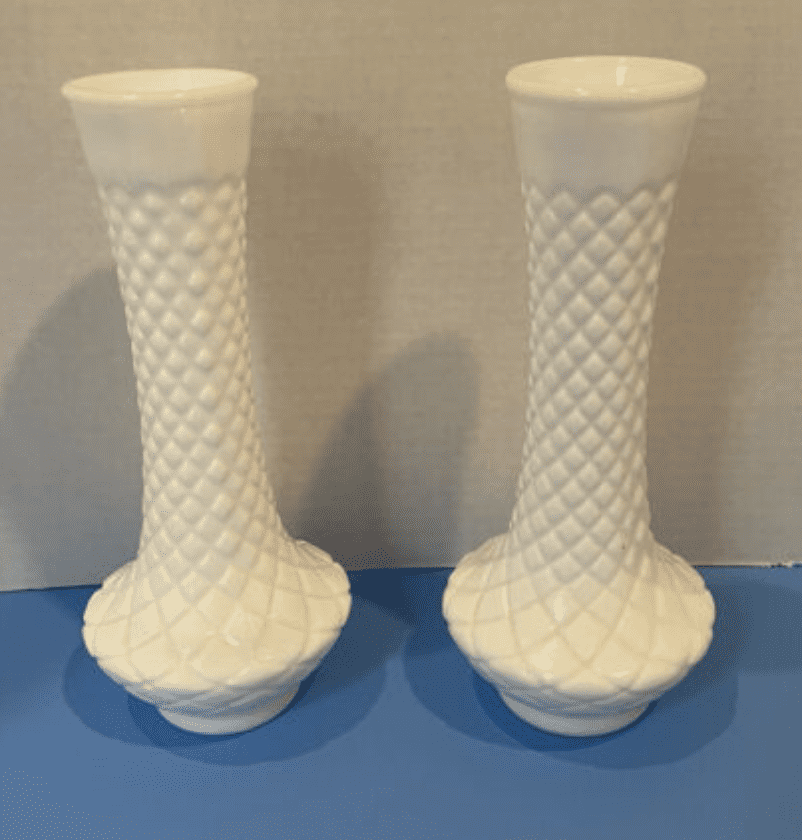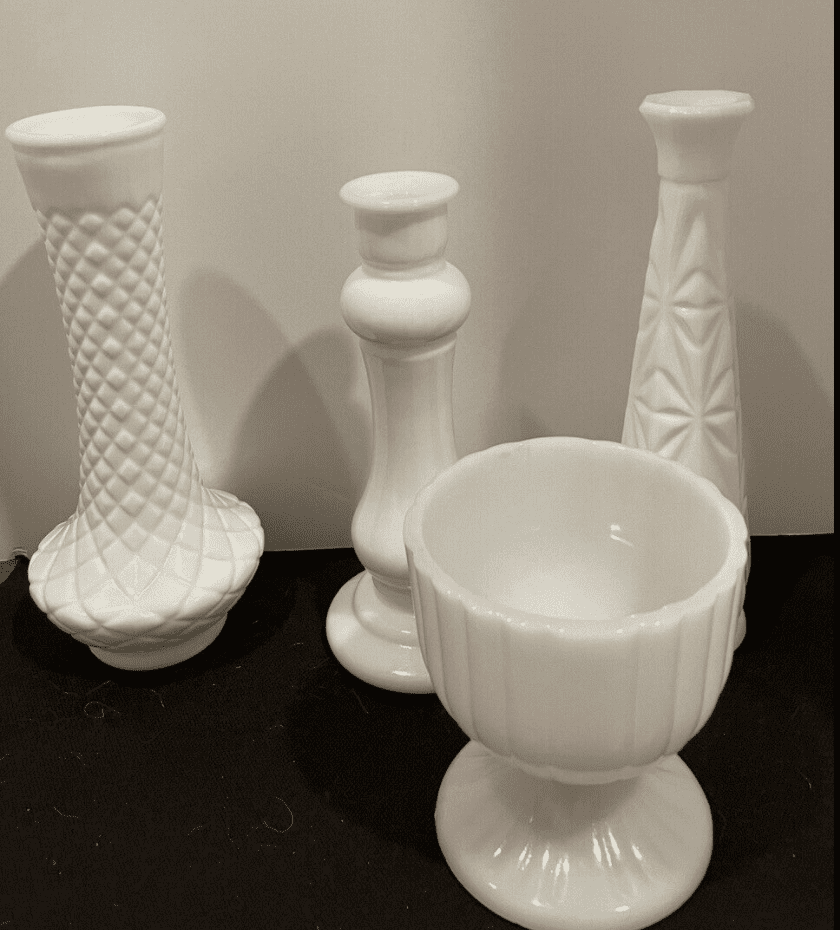Milk glass can be found anywhere from antique shows, eBay, Etsy, thrift shops, to your grandma’s kitchen. This taste of luxury for the middle class has had a very long history of ups and downs.
Milk glass is a collectible opaque white glass that can be pressed to create decorative plates, pitchers, bowls, and more. It reached peak popularity in production during the late 1800s and again during the mid-1900s with most U.S. production taking place at glass companies in the Northeast states.
The history of where and why milk glass has been produced reveals a lot about the value and character of the pieces. Keep reading for a closer look at this type of glassware and its production.

Milk Glass
Milk glass goes by a few different names, like opal glass, opaque glass, or milkglass, but they are all connected to the unique look that sets it apart from other types of glassware. When glass is mixed with an opacifier, typically tin dioxide, it takes on a solid hue. Most traditionally and commonly resulting in an almost iridescent white color, the name began as opal and later transitioned to being described as milky.
Different quantities and types of additives alter the level of opacity and can even create other creamy colors. Holding up a piece to the light may reveal a small amount of transparency. These less solidly colored pieces may be called alabaster or clambroth colored. Although less popular, colors like blue, green, and pink have shown up in milk glass at various points in history. The coloring can vary from a subtle tint to a more vibrant coloring.
Milk glass can be blown or pressed, but was typically pressed to get highly decorative edges and patterns. The most common piece would probably be decorative plates. These plates would usually have open pattern borders in lattice or lacy patterns. While much milk glassware is made for the kitchen, they are usually decorative centerpiece-type pieces. You won’t typically find full dining sets in milk glass. Pitchers, serving bowls, vases, and trays are all pretty common glassware. (Source) See also: Milk Glass Care and Usage.
Check out our full article on how milk glass is made for more information.
Purpose of Production
The gilded age produced a rapidly expanding middle class, where there used to only be upper and lower classes of income. This new class wanted to partake of the beautiful lifestyle of the upper class, but they didn’t have the same budget. Milk glass stepped in as a much cheaper alternative to porcelain. It provided the middle class with similar-looking white decorative pieces in a much more cost-effective manufacturing process.
Glass manufacturers would closely imitate the popular porcelain styles from high-end porcelain manufacturers like Wedgwood and Spode. Glass companies saw great success following current trends and marketing to the growing middle class with growing wallets. (Source)
Currently, milk glass is not so popular and is produced in much lower quantities. The more recently a piece was produced, the less valuable it becomes. The main attraction of milk glass today is for collectors. Milk glassware is a great collector’s item because of its wide availability and affordability.

Popularity Through History
The earliest production of opaque glass was seen in the 1500s in Italy. In the U.S., opaque glass was being produced by at least 1850. When people talk about milk glass, they are not typically referring to these early versions but to the more mass-produced pieces from later eras.
The first surge in popularity however didn’t begin until the late 1880s and continued through the first few years of the 1900s. This lines up perfectly with the rapid economic growth of the gilded age in the United States, especially in the North. An economic depression at the turn of the century made luxuries like decorative glassware unrealistic for most families, and the production of decorative milk glass tapered off for a time.

In the early to mid-1900s, milk glass production was much more focused on more practical uses. After all, it was still a very cheap and relatively sturdy material to produce. Milk glass was used as packaging bottles for anything from food to cosmetics. (Source)
The mid-1900s saw a resurgence of popularity for milk glass. The end of World War II helped create the image of the typical suburban American family and housewife. Glassware manufacturers monopolized the new American desire for the perfect family and home and marketed classy decorative pieces to these middle-class housewives. Eventually, the milk glass look went out of style as any trend does. (Source)
Modern milk glass is still being produced, but it is not very popular or trendy. The vintage milk glass is what people are after today. It is generally a pretty affordable collector’s item unless it is a really old piece. The various styles and mass production that occurred throughout history make pieces readily available to collectors with all sorts of style preferences.

Manufacturing
There is not a lot of information on manufacturers of glassware in the earliest stages of opaque glass, but the popularity surges make it much easier to track production. One early manufacturer of opaque glass in the United States would be the Boston & Sandwich Glass Company from Massachusetts. This company was definitely creating opaque glass by 1850.
Most of the late 1800s producers of glassware in the U.S. were located in either Pennsylvania or West Virginia. The Northern states were hotbeds for production, which was convenient since a huge portion of customers also lived in that area. Popular Pennsylvania companies included McKee & Bros, Pittsburgh and Jeannette, Dithridge & Company, and Gillinder & Sons. Some West Virginia companies during the 1800s were Eagle Glass & Manufacturing Company and the Central Glass Company of Wheeling. These are some of the most popular milk glass manufacturers from the late 1800s and early 1900s, but most glass companies from this time would produce at least some quantity of milk glass.
Fenton Art Glass Company and Westmoreland Glass Company were big names in the mid-1900s because of their signature pattern contributions to the industry. Fenton introduced hobnail, a raised dot pattern that is still popular on today’s glassware. Westmoreland popularized the paneled grape pattern that can now be found all over milk glass.
Modern manufacturers of milk glass include Anchor Hocking, Fenton, Westmoreland, and Imperial. These companies produce much more than just milk glass, since it is no longer quite as popular. (Source)
Check out our article on distinguishing between different types of milk glass.

